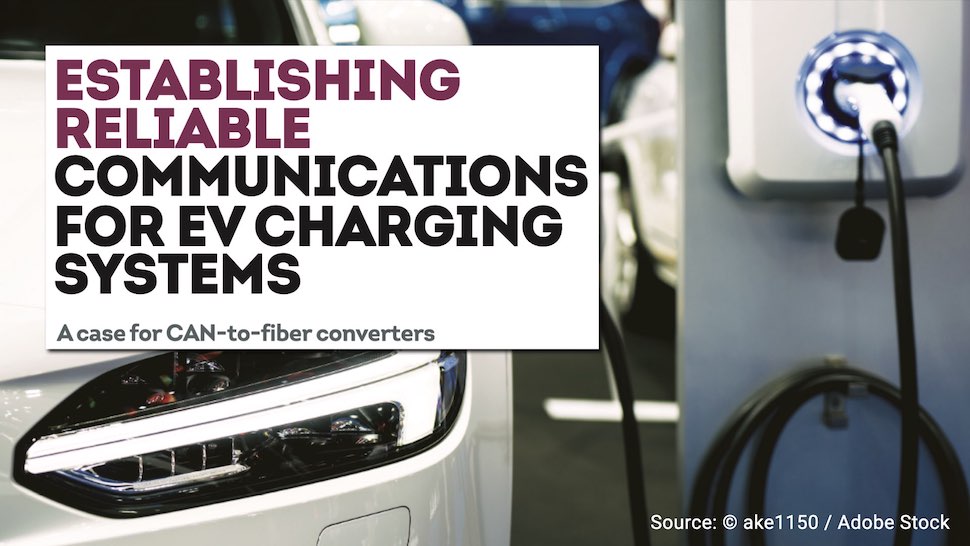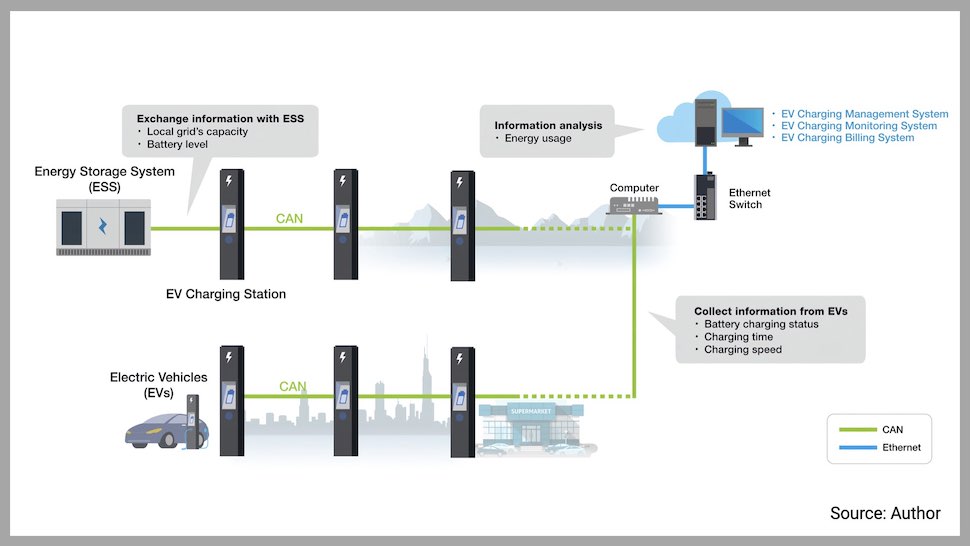
Articles
Cleantech
Electrified Transport
Features
Articles
Vehicles
A case for CAN-to-fiber converters – establishing reliable communications for EV charging systems
February 13, 2023 | By Alvis Chen

February 13, 2023 – An electric vehicle charging station (officially referred to as “electric vehicle supply equipment”, EVSE), is an electrical device that, as the name implies, recharges the batteries of electric vehicles… and their numbers are growing rapidly across North America.
In general, there are two types of EV charging stations: stand-alone and networked. Of the two, networked stations offer more benefits.
Multiple, connected charging stations helps build an EV charging system that enables operators to manage energy usage (and more) remotely. These systems collect information such as charging status and energy usage from each individual EV, and provide billing information to vehicle owners based on when they recharged, and how much electricity was used.
In addition, charging systems can exchange information with the grid and an energy storage system (ESS) to improve the stability and reliability of power supplied from the ESS to the EV charging stations. For example, when sudden demand peaks on the grid, the charging system can inform the ESS, which then opens the flow of energy it has been storing for just such an occasion.
But to truly reap the rewards of a networked system, there must be a reliable communications infrastructure.
Challenges for EV charging systems
EV charging systems rely on smooth and reliable communications to collect information and optimize charging efficiency. Whenever an EV plugs into a charger, the charging station, grid, and energy storage system exchange a variety of operational data (e.g. battery charging status, electricity capacity, energy usage) through either a wireless or wired network.
The information is also sent to the system’s control centre for analysis, helping operators draw insights on exactly how much power may be required at certain times of the day.
CAN communication protocols limitation
The controller area network (CAN) bus protocol has been widely adopted across electric vehicles and charging stations for communications; thus, for a charging system to be operational, it must be able to communicate in CAN bus.
However, baud rates can limit the transmission distance of a CAN system (as stated in ISO 11898-1:2015 “Controller area network [CAN]”. The faster the baud rate, the shorter the maximum transmission distance. In other words, the maximum transmission length of a CAN system for a given baud rate cannot be extended.
To overcome this limitation and enable greater flexibility with charging station deployments, a networking solution is needed to deliver the expected baud rates over extended communication distances.
Finding suitable communication interfaces
Quite often, EV charging stations that are run by a single operator are located far apart from each other, making it difficult to connect them. For example, EV charging stations can be separately deployed between buildings or in suburbs, requiring a networking solution that can achieve long-distance communications.
Some stations adopt wireless connectivity to share or transmit battery/electricity data, thereby lowering the wiring deployment cost. However, many EV charger manufacturers and system integrators experience wireless signal coverage that is well below expectations, often due to environmental conditions. As such, they prefer wired data connections for increased reliability and a better user experience.
To achieve reliable wired connections, fiber optic cables should be adopted to provide isolation and protection against electromagnetic interferences, and for their ability to transmit over long distances.
Reliable CAN-to-fiber solutions
CAN-to-fiber converters help provide reliable communications for EV charging systems because they break the limit of CAN bus communication, and are able to transmit up to 1 Mbps in CAN interfaces, or up to 5 Mbps in CAN FD interfaces, thereby extending communications distances up to 40 kilometres.

As networking devices are usually deployed inside space-limited cabinets in outdoor environments, the ideal CAN-to-fiber converter would come with 2-kV isolation and 2-kV surge protection for the CAN port, and be able to operate across a wide temperature range across a variety of outdoor environments.
Connecting many EV charging stations to a control centre will require multiple CAN-to-fiber converters to achieve long-distance communication. To make multiple device configurations easier, CAN-to-fiber converters should have DIP switch-to-switch interfaces between CAN and CAN FD (flexible data-rate). In addition, CAN-to-fiber converters should feature an automatic baud rate setting function for the CAN interface to eliminate the need to perform complicated configurations.
Another handy feature would be LED indicators that can help quickly identify whether an error occurred in the CAN or fiber connection.
Opportunities keep growing
The transition to electric vehicles—and fully electrified transport—will take many years to fully develop and mature, but it is very much underway. S&P Global projects 7.8 million electric vehicles in operation by 2025, globally. And, by 2030, that number is expected to reach 28.3 million.
With this transition comes a critical need to evolve our EV charging network, since the present infrastructure is clearly insufficient to support a drastic increase in the number of electric vehicles.
CAN-to-fiber converters can help in the successful expansion of charging stations by providing more reliable communications and, ultimately, making them profitable and manageable for operators.
Alvis Chen is the global marketing, integrated marketing project manager at Moxa. He has a Master’s degree in electrical and electronics engineering from National Chung Cheng University.
You’ll find all Back Issues of Electrical Business Magazine in our Digital Archive.
Print this page
